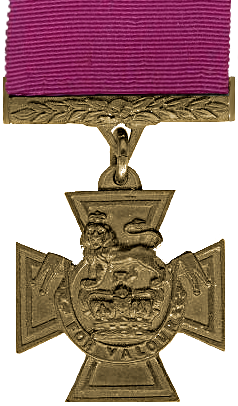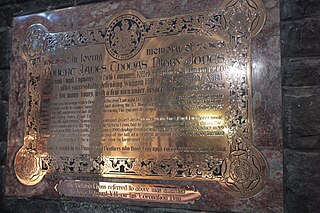During the Second World War, Jock columns were small combined arms groups of armoured cars, artillery and motorised infantry, generally drawn from the British 7th Armoured Division. They were used in the Western Desert Campaign by the British Army to harass German and Italian forces. The columns were named after an officer who was a superb exponent of the tactic and may have conceived it originally, Lieutenant Colonel John Charles "Jock" Campbell.

Gordon Muriel Flowerdew was an English-born Canadian recipient of the Victoria Cross, the highest and most prestigious award for gallantry in the face of the enemy that can be awarded to British and Commonwealth forces, received for his actions at the Battle of Moreuil Wood.

Edward Colquhoun Charlton VC was an English recipient of the Victoria Cross, the highest and most prestigious award for gallantry in the face of the enemy that can be awarded to British and Commonwealth forces.

Rifleman John Beeley VC was a British Army soldier and an English recipient of the Victoria Cross (VC), the highest and most prestigious award for gallantry in the face of the enemy that can be awarded to British and Commonwealth forces.

Lieutenant-Colonel Bertram Best-Dunkley VC was an English recipient of the Victoria Cross, the highest and most prestigious award for gallantry in the face of the enemy that can be awarded to British and Commonwealth forces.

Lieutenant-Colonel Victor Buller Turner was a British Army officer and an English recipient of the Victoria Cross (VC) during the Second World War, the highest award for gallantry in the face of the enemy that can be awarded to members of British and other Commonwealth forces.

Major-General John Charles Campbell,, known as Jock Campbell, was a British Army officer and recipient of the Victoria Cross, the highest award for gallantry in the face of the enemy that can be awarded to British and Commonwealth forces.

Captain James Joseph Bernard Jackman VC was an Irish posthumous recipient of the Victoria Cross, the highest and most prestigious award for gallantry in the face of an enemy that can be awarded to British and Commonwealth forces.

Joseph Henry Collin VC was an English recipient of the Victoria Cross, the highest and most prestigious award for gallantry in the face of the enemy that can be awarded to British and Commonwealth forces.

Robert James Thomas Digby-Jones was a Scottish recipient of the Victoria Cross, the highest and most prestigious award for gallantry in the face of the enemy that can be awarded to British and Commonwealth forces.
Lieutenant Colonel Sir John Reginald Noble Graham, 3rd Baronet, was a British businessman, army officer and a recipient of the Victoria Cross, the highest award for gallantry in the face of the enemy that can be awarded to British and Commonwealth forces. He received the award "for most conspicuous bravery, coolness and resource when in command of a Machine Gun Section" during the Samarra offensive in 1917, during the First World War.

Clement Robertson was a Colony of Natal-born, recipient of the Victoria Cross, the highest and most prestigious award for gallantry in the face of the enemy that can be awarded to British and Commonwealth forces.

The Ordnance QF 2-pounder, or simply "2 pounder gun", was a 40 mm (1.575 in) British anti-tank gun and vehicle-mounted gun employed in the Second World War.

Portée describes the practice of carrying an artillery piece on a truck which can be fired from the vehicle or quickly dismounted and fired from the ground. The term is most often used to describe anti-tank equipments used by the British, Commonwealth and imperial forces in the Western Desert Campaign of the Second World War. Modern terms for mounting weapons on vehicles are technical or gun truck.

The 8th King's Royal Irish Hussars was a cavalry regiment in the British Army, first raised in 1693. It saw service for three centuries including the First and Second World Wars. The regiment survived the immediate post-war reduction in forces, and went on to distinguish itself in the battles of the Korean War, but was recommended for amalgamation in the 1957 Defence White Paper prepared by Duncan Sandys. The regiment was amalgamated with the 4th Queen's Own Hussars, to form the Queen's Royal Irish Hussars in 1958.
3rd Regiment Royal Horse Artillery is a regiment of the Royal Horse Artillery in the British Army. They are currently based at Albemarle Barracks, Northumberland, England.
J Battery Royal Horse Artillery are a Close Support Battery of 3rd Regiment Royal Horse Artillery. They were currently based in Caen Barracks in Hohne, Germany.
The second battle of Bàu Bàng occurred during the night of 19–20 March 1967 during Operation Junction City, a search and destroy mission by American military forces in Tay Ninh Province of South Vietnam, to the west of the capital Saigon.

The 7th Anti-Tank Regiment was an anti-tank artillery regiment of the New Zealand Military Forces raised during the Second World War. It saw service as part of the 2nd New Zealand Division during the Greek, North African, Tunisian and Italian campaigns, before being disbanded in December 1945.














